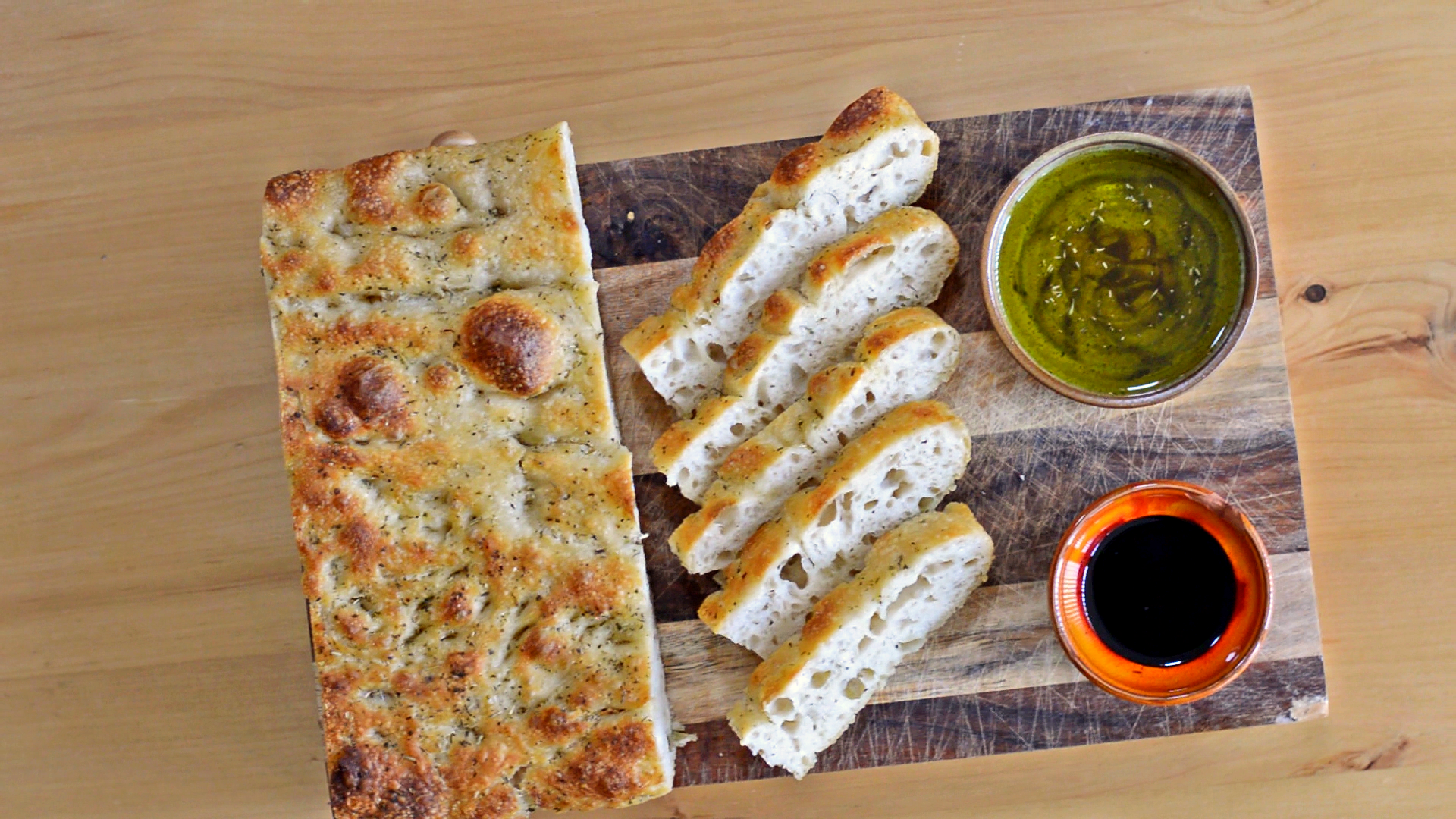Got any spare dough ?
Do you want spare dough?
In this video, I’ll be using my go-to dough recipe to show you how we make our focaccia.
I love this dough, I using it for everything, from pizzas to sandwich loaves. As an introduction to bread though, there’s no better, or simpler bread, than focaccia.
For the full recipe with ingredients, click to read on.
Measurement note: With all my dough recipes, I’ll usually use the a percentage system of measurement. It’s a system used by bakers to scale their recipes based on the amount of flour used.
For example, if I want a dough that’s 65% water with 2% salt and a 1.5% fresh yeast, then I’ll need 500g of flour, which gives us:
[space]
|
Ingredient
|
Weight
|
Baker’s Percent
|
|
Flour
|
500g
|
100%
|
|
Water
|
325g
|
65%
|
|
Salt
|
10g
|
2%
|
|
Fresh Yeast
|
7.5g
|
1.5%
|
[space]
In the recipe used in the video, I’ve used 1kg of flour, which should produce enough dough to fill a 40x30cm baking tin.
Halving this recipe (to give the one above) will halve the surface area of the tin you’ll need (so you can use either a 40x15cm or 20x3cm tin)
[space]
Prepare the dough
[space]
Mix the flour, salt, water and yeast in a mixing bowl to form a shaggy mass. (2 mins)
- 1000g strong bread flour
- 650g water at finger temp (35-38°C)
- 20g salt
- 100g sourdough or 7g / 1 pack of dry yeast
[space]
For more on yeast and sourdough cultures, have a look at our Sourdough Oats Experiment
[space]
Rest the dough, allowing the flour to fully hydrate (20 mins)
This will reduce the amount of kneading required later on in a process know as autolisis.
[space]
Knead the dough using the slap and fold (French Slap) technique. (6-8 mins) [1:42-2:16 in the video]
[space]
Cover the dough with cling film and let it rest in the fridge overnight ( ~ 12 hour)
[space]
The next day, the dough can be transferred to a baking tin and allowed to prove before baking.
[space]
[space]
After overnight fermentation
[space]
Dust the baking tin with flour.
[space]
Transfer the dough from the fridge to the baking tin. Dust with additional flour.
[space]
Cover the dough with cling film and let it prove somewhere warm to rise to about 1.5/2 times its volume. (3-6 hours)
The proving time will always vary according to temperature and the amount of yeast used. Since the ‘leave it for 2 hours’ line’s essentially made up, try poking the dough. If an indentation left by your finger remains prominent, it’s ready, if it bounces back, it’s not done proving.
You can also try using you oven as a proving draw by heating it to 30°C in short bursts, but this is not necessarily good advice as it seldom ends well.
[space]
30 mins before baking. Preheat the oven to 240°C. [ 3:13 – 3:23 ]
This would be the time to preheat your baking stone and steam pan if you’re feeling up for a little excitement.
[space]
When dough’s done proving, remove the cling film and drench it in oil (don’t be shy). [ 3:22 – 3:30 ]
The dough should be pillow-like at this point, with the odd bubble appearing as the dough’s disturbed.
- 100-200 ml Olive Oil
[space]
Press down the dough, indenting it with your fingertips. [ 3:32 – 3:42 ]
Now’s the time to add toppings such as sun-dried tomatoes or garlic, making sure to really press them down into the dough so that they become encompassed.
- Toppings of your choice
[space]
Transfer the focaccia to the preheated oven and bake at 200-180°C. ( 20-23 mins)
If you have a preheated baking stone and steam pan, slide the dough in its tin onto the stone before pouring around a cup of boiling water onto the steam pan underneath. Be very careful not protect your hand (with a towel or glove) from being burnt by the sudden burst of steam.
Also be wary of letting too much water come into contact with your oven door as there’s a risk it may cause the glass to break.
[space]
Remove the focaccia from the oven when the crust is golden with brown spots and the middle registers at 95°C.
[space]
Use a spatula to release the focaccia from it’s tin (if necessary) before allowing it to cool on a wire rack
[space]
Once the focaccia’s cooled and baked off completely, go ahead to cutting and serving.
[space]
More to try
[space]
If you’ve got a taste for focaccia, we’ve a load of sauces and dips for you to try. For a taste of Liguria, have a go at our Pesto recipe. Or for a more Greek inspired taste, check out our Olive Tapanade, all to come.



